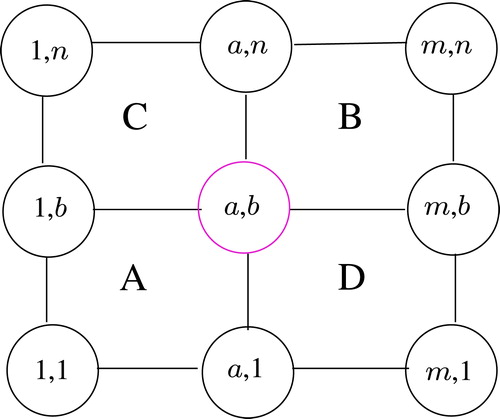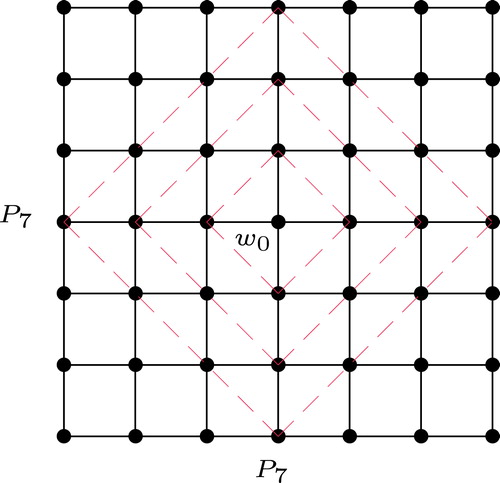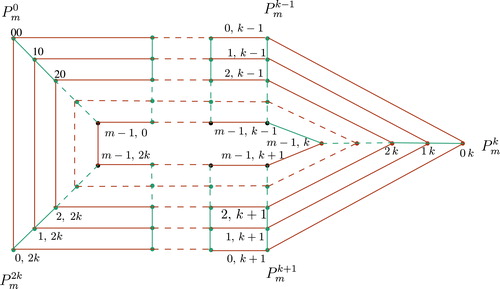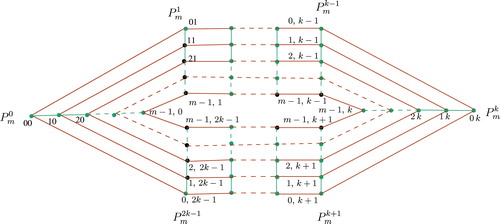 ?Mathematical formulae have been encoded as MathML and are displayed in this HTML version using MathJax in order to improve their display. Uncheck the box to turn MathJax off. This feature requires Javascript. Click on a formula to zoom.
?Mathematical formulae have been encoded as MathML and are displayed in this HTML version using MathJax in order to improve their display. Uncheck the box to turn MathJax off. This feature requires Javascript. Click on a formula to zoom.Abstract
Betweenness centrality is a widely used measure in various graphs and it has a pivotal role in the analysis of complex networks. It measures the potential or power of a node to control the communication over the network. The computation is based on the assumption that information primarily flows over the shortest paths between the nodes of the network. In a graph, the power of a vertex is not an individual attribute, it depends on the influence of other vertices present. Betweenness centrality measures the extent to which a vertex becomes part of the shortest paths between pairs of other vertices in a graph. In this paper, we establish expression for betweenness centrality in Cartesian product of graphs. And investigate the same on certain graphs such as grid, Hamming graphs, hypercubes, Cartesian product of cycles etc.
1 Introduction
Several centrality measures have so far been studied and their importance is increasing day by day. Betweenness centrality has a vital role in the analysis of networks. Citation[1–4] It has many applications in a variety of domains such as biological networks Citation[5–9], study of sexual networks and AIDS [Citation10], identifying key actors in terrorist networks [Citation11], transportation networks [Citation12], supply chain management [Citation13], bio-informatics–protein interaction networks Citation[14,15], food webs [Citation16] etc. Betweenness centrality Citation[17,18] indicates the betweenness of a vertex (or an edge) in a network and it measures the extent to which a vertex (or an edge) lies on the shortest paths between pairs of other vertices. It is quite difficult to find out the betweenness centrality of a vertex in a large graph. The computation of this index based on direct application of definition becomes impractical when the number of vertices is huge since it has complexity in the order of
. The fastest exact algorithm due to Brandes [Citation19] requires
space and
time where
is the number of vertices and
the number of edges in the graph. Exact computations of betweenness centrality can take a lot of time. But a large network can be thought of as it is made by joining smaller networks together. There are several graph operations which results in a larger graph and hence many of the properties of larger graphs can be derived from its constituent subgraphs. Graph operations are helpful for constructing new classes of composite graphs. Cartesian product is an important graph operation.
It is assumed that the graphs under consideration are simple undirected connected graphs.
2 Background
The concept of betweenness centrality of a vertex was first introduced by Bavelas in 1948 [Citation20]. The importance of the concept of vertex centrality lies on how a vertex acts as a bridge among pairs of vertices in joining them by shortest paths. It gives the potential of a vertex for control of information flow in the network Citation[21,22]. The following terminology is used. The order of a graph , denoted by
, is the number of vertices in
. i.e.,
. The distance between two vertices
, denoted by
, is the length of any shortest
-
path in
. A shortest
-
path is also called a u-v geodesic. A graph
is a geodetic graph [Citation23] if every pair of vertices of
is connected by a unique shortest path. The diameter,
, of a graph
is given by
. Two vertices
and
of
satisfying
are extreme vertices [Citation24]. For a connected graph
and
, the interval
between
and
is defined as the set of vertices that lie on shortest
-
paths; that is,
A graph is vertex-transitive if every vertex in
can be mapped to any other vertex by some automorphism. A subgraph
of a graph
is isometric in
if
for all
. A subgraph
of a graph
is (geodesically)convex in
if
contains all
-
geodesics of
for
.
A definition to betweenness centrality of a vertex in a graph , given by Freeman [Citation25] is as follows
Definition 2.1
Betweenness Centrality If , the betweenness centrality
for
is defined as
where
is called the pair-dependency of the pair
on
. It is defined as
where
is the number of shortest
-
paths and
is the number of shortest
-
paths containing
.
Observe that lies on the shortest
-
path iff
. The number of shortest
-
paths passing through
is given by
Definition 2.2
Cartesian Product, [Citation26] The Cartesian product of two graphs and
, denoted by
, is a graph with vertex set
, where two vertices
and
are adjacent if
and
, or
and
. The graphs
and
are called factors of the product
.
For any , the subgraph of
induced by
is called
-fiber or
-layer, denoted by
. Similarly, we can define
-fiber or
-layer. They are isomorphic to
and
respectively.
contains
copies of
and
copies of
. Projections are the maps from a product graph to its factors. They are weak homomorphisms in the sense that they respect adjacency. The two projections on
namely
and
defined by
and
refer to the corresponding
-,
- coordinates. Thus an edge in
is mapped into a single vertex by one of the projections
or
and mapped into an edge by the other. If
and
are connected, then
is also connected. Furthermore, the minimum degree denoted by
is additive under Cartesian products, i.e.
. Assuming isomorphic graphs are equal, Cartesian product is commutative as well as associative.
Lemma 2.1
[Citation27] Let and
be connected graphs. Then all
-fibers and
-fibers are convex subgraphs of
.
Definition 2.3
Cartesian Product of Several Graphs, [Citation27] The Cartesian product of graphs
is defined on the
-tuples
, where
in such a way that two
-tuples
and
are adjacent if there exists an index
such that
and
for
. The
-tuple
is called coordinate vector, and the
are the coordinates.
The Cartesian product of
-factors is briefly denoted as
. The
th Cartesian product of a graph
is denoted as
. It is to be noted that the product
is connected if and only if each of its factor
is connected and the diameter of the product is given by,
.
Proposition 2.1
[Citation28] The Cartesian product is vertex-transitive, if
is vertex-transitive for each
The following proposition shows that the distance between two vertices in the product graph is the sum of the distance between their projections in the factor graphs.
Lemma 2.2
[Citation29] If and
are vertices of a Cartesian product
, then
(1)
(1)
This can be generalized to the following lemma.
Lemma 2.3
Distance Lemma [Citation29] Let be the Cartesian product
of connected graphs, and let
and
be vertices of
. Then
Lemma 2.2 implies that . In other words,
restricted to
is
. It means that every shortest path in a
-fiber (or
-fiber) ia also a shortest path in
. Consider the following betweenness property of vertices in product graph.
Proposition 2.2
[Citation27] Let and
be two vertices of
, then the vertex
lies in
if and only if
and
.
It can be generalized as the following
Proposition 2.3
[Citation27] Let . Let
,
and
be any three vertices in
. Then
if and only if
.
3 The betweenness centrality of vertices in Cartesian product of graphs
The following proposition shows how the number of geodesics between two vertices and
in a product graph
is related to the number of geodesics between their projections in the factor graphs.
Proposition 3.1
If and
are vertices in
, then the number of shortest
-
paths in
is given by
(2)
(2)
Proof
Consider the vertices and
in
. Let
denote the distance between
and
in
. Suppose there exist unique shortest paths between
and
in
and
and
in
. A shortest path from
to
is a sequence of
edges and the image of each edge under the projections
and
is an edge lying between
and
or
and
. If the sequence of
edges of the
-
path in
makes a sequence of
edges in
and a sequence of
edges in
, then
. Since
and
are the same for any shortest
-
path, the number of shortest paths between
and
in
is the number of ways of selecting
edges (or
edges) from
edges which is
. If there exist
shortest paths between
and
in
and
shortest paths between
and
in
, then corresponding to each pair, there exist
shortest paths between
and
in
.
Therefore,
For brevity, we may write □
Corollary 3.1
If and
are geodetic graphs, then the number of shortest paths between
and
in
is given by
By the associativity of , Eq. (2) can be generalized as
Proposition 3.2
Let . If
,
are two vertices in
such that
,
and
, then
Corollary 3.2
Let where each
are geodetic. If
,
are two vertices in
such that
and
, then
Proposition 3.3
Let ,
and
be any three vertices in
. Then
(3)
(3)
Theorem 3.1
The betweenness centrality of in
is given by
where
with
Proof
The result follows from the definition of betweenness centrality and from Eqs. (1)–(3)
Hence
Definition 3.1
Wiener Index of a Graph, [Citation30] The Wiener index of a graph , denoted by
is the sum of the distances between all (unordered) pairs of vertices of
. i.e.,
or,
Wiener index is also named total status or total distance of a graph. The Wiener index of Cartesian product Citation[31–33] of two graphs and
is given by
It can be extended to
(4)
(4) The betweenness centrality of
is given by
If
is vertex transitive, the betweenness centrality of
is given by
(5)
(5)
3.1 Grid graphs
Grid graphs are the Cartesian product of path graphs. represents a rectangular grid
. If
and
are any two vertices of
, then
(
-metric) and
where
or
.
Consider the rectangular grid given in . Take a vertex
in
; then
, where
. The paths
and
passing through
divide the rectangular grid into four quadrants
sharing their common sides. Any pair of vertices lying in the diagonal regions
or
makes a contribution to the betweenness centrality of
. Hence
Lemma 3.1
In an grid, for any inner vertex
, the vertices at a distance
from
induces it the betweenness centrality
Proof
Consider the -neighborhood (
-nbd) of
where
. Each
-nbd of
contains
vertices at a distance
from
for
and they are lying on a rhombus as in ). Consider the vertices
and
lying on opposite sides of the rhombus where
and
for
such that
. Now the pair
induces the betweenness centrality
to
. Split the distance
into
, the horizontal and vertical components and consider the pairs of vertices
for each
. It can be easily seen that they contribute the betweenness centrality 2 for
; 4 for
; 2 for
. Thus the betweenness centrality induced by the vertices at a distance
is given by
.□
Theorem 3.2
In an grid, for any vertex
, the
-nbd of
where
denoted by
contains
vertices and the betweenness centrality of
induced by
is given by
Proof
Let be an inner vertex of the
grid. Then the pairs of vertices
for
and
such that
induces a betweenness centrality
. Since there exist
pairs of
for
, the pairs of vertices at a distance
induce a betweenness centrality
. To find the betweenness centrality of
induced by
, consider
for
and we get
Remark 1
Using Corollary 3.2 the number of geodesics of length in the grid
from
to
obtained follows the
-ary de Bruijn sequence
where
(
)
3.2 Hamming graphs
Hamming graphs are Cartesian products of complete graphs. i.e., for some
and
. The vertices of
can be labeled with vector
where
. Two vertices of
are adjacent if the corresponding vectors differ in precisely one coordinate. The distance (named Hamming distance) between two vertices
and
denoted by
is the number of positions in which the two vectors differ.
Hypercubes are Cartesian product of complete graphs . An
-dimensional hypercube (or
-cube) denoted by
is given by,
. It can also be defined recursively,
. Hypercubes are important classes of graphs having many interesting structural properties. The number of geodesics between
is given by
. For a connected graph
, the condition “
induces a
-dimensional hypercube for any two vertices
and
of
” implies that
is a Hamming graph [Citation24].
The following lemma highlights the importance of Hamming graphs.
Lemma 3.2
[Citation34] A graph is a nontrivial subgraph of the Cartesian product of graphs if and only if
is a nontrivial subgraph of the Cartesian product of two complete graphs.
Proposition 3.4
Let be the Hamming graph given by
. Then the betweenness centrality of
is given by
Proof
Let . Since
is vertex transitive, from Eqs. (4) and (5),
Corollary 3.3
If ,
and
are complete graphs, then for
for
Corollary 3.4
If , then
when
,
, the
-cube, then
3.3 Product of cycles
Consider the product of cycles . Now from Eqs. (4) we get for
(6)
(6) and for
(7)
(7) For any
,
when
is even, and
when
is odd. Now from Eqs. (5)–(7) we get
Proposition 3.5
If is the Cartesian product of
even cycles. i.e.,
,
, then for
if
,
Proposition 3.6
If is the Cartesian product of
odd cycles. i.e.,
,
, then for
Corollary 3.5
Consider two cycles and
. Let
then
In another form,
3.4 Product of path and cycle
Consider . Then
has
layers of
(also
layers of
) and it can be embedded on the surface of a cylinder.
Theorem 3.3
Let . Then for
Case 1
If
Case 2
If
Proof
Let where
and
. Since each layer of
is vertex-transitive, it is enough to find
for only one layer of
.
Case 1. When is odd□
Let . Consider the vertices of
, i.e.,
. First consider the vertex
. It is in the outer layer, see . There are
vertices other than
in this layer. The betweenness centrality of
is the sum of the contributions of this outer layer
with itself and with inner layers
. By symmetry, we consider only the
vertices on
, i.e.,
. Each vertex in
make pairs with
consecutive vertices
of the same layer and give the betweenness centrality
to
. i.e., the layer
contributes
to the betweenness centrality of
.
Now we find the contribution of the outer layer with inner layers. By symmetry, we consider the set of vertices of the outer layer making pairs with
consecutive vertices of inner layers
, (i.e., with vertices lying between the layers
and
) and the vertex
making pairs with the vertices of the layer
except
and double the value got in these two cases. Since
and
are geodetic we can use the formula given in Corollary 3.1 to find the number of shortest paths in the product graph. i.e., if
then the contribution of this pair to
is
If denote the layers
respectively. Then the contribution of
with other layers to the betweenness centrality of the vertex
is given by
etc.
Therefore, if
denotes the
th harmonic number i.e.,
with
, then
(8)
(8)
Consider the vertex on
. Now from Eq. (8) the vertices of
with
give the betweenness centrality
, and with
give
. Again the vertices of
with
give the betweenness centrality
Combining these we get,
Similarly, for the vertex ,
and
with inner layers
contribute betweenness centrality
Therefore,
In general,
By symmetry,
Again,
Case 2. When is even□
Let . As in Case 1., we can evaluate the betweenness centrality of each vertex on
. But since the graph is even, for each pair of vertices lying on extreme path layers, there are two geodesics joining them and one of them passes through
. So we have to multiply last terms of each expression in Case 1. by
. See
The contribution of with other layers to the betweenness centrality of the vertex
is as follows
etc.
Therefore,
(9)
(9) Consider the vertex
on
. Now from Eq. (9), the vertices of
with
give the betweenness centrality
, and
with
give
. The vertices of
with
give the betweenness centrality
Combining these we get,
Similarly,
In general,
By symmetry,
Again,
Corollary 3.6
The graph is vertex transitive only when
known as cycle prism. The betweenness centrality of cycle prism is given by
4 Conclusion
A composite graph can be constructed by applying different graph operations on smaller graphs and many of the structural properties of the composite graphs can be studied from its constituent smaller graphs. An expression for the betweenness centrality of Cartesian product of graphs has been derived and examined for different graph products. This can be extended to other graph-products such that an investigation on the behavior of centrality of larger graph can be made from the platform of its constituent smaller graphs.
References
- de PasqualeFet al., A dynamic core network and global efficiency in the resting human brain Cerebral Cortex2015 bhv185
- Ana MMartín GonzálezBoDalsgaardJens MOlesen, Centrality measures and the importance of generalist species in pollination networks Ecol. Complex. 7 1 2010 36–43
- MikailRubinovOlafSporns, Complex network measures of brain connectivity: uses and interpretations Neuroimage 52 3 2010 1059–1069
- MarcelSalathéet al., A high-resolution human contact network for infectious disease transmission Proc. Natl. Acad. Sci. 107 51 2010 22020–22025
- HawoongJeonget al., Lethality and centrality in protein networks Nature 411 6833 2001 41–42
- JPinneyGMcConkeyDWesthead, Decomposition of biological networks using betweenness centrality Proc. 9th Ann. Int’l Conf. on Research in Computational Molecular Biology (RECOMB 2005)2005
- AntonioDel SolHirotomoFujihashiPaulO’Meara, Topology of small-world networks of protein–protein complex structures Bioinformatics 21 8 2005 1311–1315
- DirkKoschützkiFalkSchreiber, Centrality analysis methods for biological networks and their application to gene regulatory networks Gene Regulation and Systems Biology, Vol. 22008Libertas Academica193
- ErnestoEstrada, Virtual identification of essential proteins within the protein interaction network of yeast Proteomics 6 1 2006 35–40
- FredrikLiljeroset al., The web of human sexual contacts Nature 411 6840 2001 907–908
- Valdis EKrebs, Mapping networks of terrorist cells Connections 24 3 2002 43–52
- RogerGuimeraet al., The worldwide air transportation network: anomalous centrality, community structure, and cities’ global roles Proc. Natl. Acad. Sci. 102 22 2005 7794–7799
- DraganCisicBlankaKesicLivijJakomin, Research of the power in the supply chain International Trade, Economics Working Paper Archive EconWPA (April 2000)2000
- JoyMaliackal Pouloet al., High-betweenness proteins in the yeast protein interaction network BioMed Res. Int. 2005 2 2005 96–103
- JingChenBruce JAronowAnil GJegga, Disease candidate gene identification and prioritization using protein interaction networks BMC Bioinform. 10 1 2009 1
- FerencJordán, Keystone species and food webs Philos. Trans. R. Soc. B 364 1524 2009 1733–1741
- Stephen PBorgattiMartin GEverett, A graph-theoretic perspective on centrality Soc. Netw. 28 4 2006 466–484
- UlrikBrandes, On variants of shortest-path betweenness centrality and their generic computation Social Networks 30 2 2008 136–145
- UlrikBrandes, A faster algorithm for betweenness centrality* J. Math. Sociol. 25 2 2001 163–177
- ABavelas, A mathematical model for group structure, human organization 7, 1630 Appl. Anthropol. 7 3 1948 16–30
- UlrikBrandesDanielFleischer, Centrality Measures Based on Current Flow2005Springer
- Stephen PBorgatti, Centrality and network flow Soc. Netw. 27 1 2005 55–71
- OysteinOre, Theory of Graphs, Vol. 381962American Mathematical Society Colloquium Publications
- Henry MartynMulder, The interval function of a graph MC Tracts 1321980 1–191
- Linton CFreeman, A set of measures of centrality based on betweenness Sociometry1977 35–41
- GertSabidussi, Graphs with given group and given graph-theoretical properties Canad. J. Math 9 515 1957 C525
- WilfriedImrichSandiKlavzarDouglas FRall, Topics in Graph Theory: Graphs and their Cartesian Product2008CRC Press
- JunmingXu, Theory and Application of Graphs, Vol. 102013Springer Science & Business Media
- RichardHammackWilfriedImrichSandiKlavžar, Handbook of Product Graphs2011CRC press
- HarryWiener, Structural determination of paraffin boiling points J. Am. Chem. Soc. 69 1 1947 17–20
- AnteGraovacTomažPisanski, On the Wiener index of a graph J. Math. Chem. 8 1 1991 53–62
- Yeong-NanYehIvanGutman, On the sum of all distances in composite graphs Discrete Math. 135 1–3 1994 359–365
- MatthiasDehmerFrankEmmert-Streib, Quantitative Graph Theory: Mathematical Foundations and Applications2014CRC Press
- SandiKlavžarIztokPeterin, Characterizing subgraphs of Hamming graphs J. Graph Theory 49 4 2005 302–312




